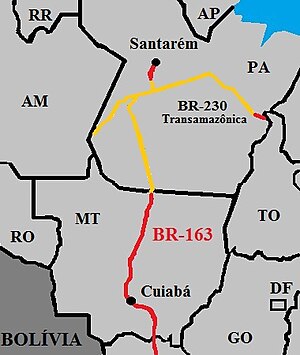BR-163 (Brazil highway): Difference between revisions
Appearance
Content deleted Content added
No edit summary |
No edit summary |
||
| Line 1: | Line 1: | ||
[[File:BR163CuiabáSantarém.jpg|thumb|300px|BR-163 Cuiabá-Santarém]] |
[[File:BR163CuiabáSantarém.jpg|thumb|300px|BR-163 Cuiabá-Santarém]] |
||
[[File:BR163CuiabáRS.jpg|thumb|300px|BR-163 Cuiabá-Rio Grande do Sul]] |
[[File:BR163CuiabáRS.jpg|thumb|300px|BR-163 Cuiabá-Rio Grande do Sul]] |
||
'''BR-163''' is a [[highway]] in [[Brazil]], going from [[Cuiabá]], the capital city of [[Mato Grosso]] state, to [[Santarém, Pará|Santarém]] in the state of [[Pará]]. It runs through {{convert|1,780|km|mi|abbr=on}} in the heart of the [[Amazon Basin]] |
'''BR-163''' is a [[highway]] in [[Brazil]], going from [[Cuiabá]], the capital city of [[Mato Grosso]] state, to [[Santarém, Pará|Santarém]] in the state of [[Pará]]. It runs through {{convert|1,780|km|mi|abbr=on}} in the heart of the [[Amazon Basin]]. As part of the ''[[Avança Brasil]]'' project, it has been proposed to pave the road in its entirety. |
||
Conservationists{{Who|date=September 2010}} worry that paving the road will lead to [[deforestation]] in the Amazon through greater access to pristine areas, cheaper transportation costs for [[soybean]]s and other agricultural commodities, and [[land speculation]] along the highway. |
Conservationists{{Who|date=September 2010}} worry that paving the road will lead to [[deforestation]] in the Amazon through greater access to pristine areas, cheaper transportation costs for [[soybean]]s and other agricultural commodities, and [[land speculation]] along the highway. |
||
Revision as of 09:26, 9 April 2013


BR-163 is a highway in Brazil, going from Cuiabá, the capital city of Mato Grosso state, to Santarém in the state of Pará. It runs through 1,780 km (1,110 mi) in the heart of the Amazon Basin. As part of the Avança Brasil project, it has been proposed to pave the road in its entirety.
Conservationists[who?] worry that paving the road will lead to deforestation in the Amazon through greater access to pristine areas, cheaper transportation costs for soybeans and other agricultural commodities, and land speculation along the highway.
It's estimated that up to 80% of the road is currently re-paved.[1]
References
- Christian Science Monitor
- Philip Fearnside. 2001. "Soybean Cultivation as a Threat to the Environment in Brazil". Environmental Conservation 28 (1):23-28.
- Maria del Carmen Vera-Diaz, Robert K. Kaufmann and Daniel C. Nepstad. 2005. "The Environmental Impacts of Soybean Expansion and Infrastructure Development in
Brazil’s Amazon Basin. Global Development and Environment Institute Working Paper NO. 09-05"
External links
- Template:En icon Al Jazeera video report on the BR-163
- http://science.nationalgeographic.com/science/earth/habitats/last-of-amazon.html
As of March 2013, the road is about 80% paved.
